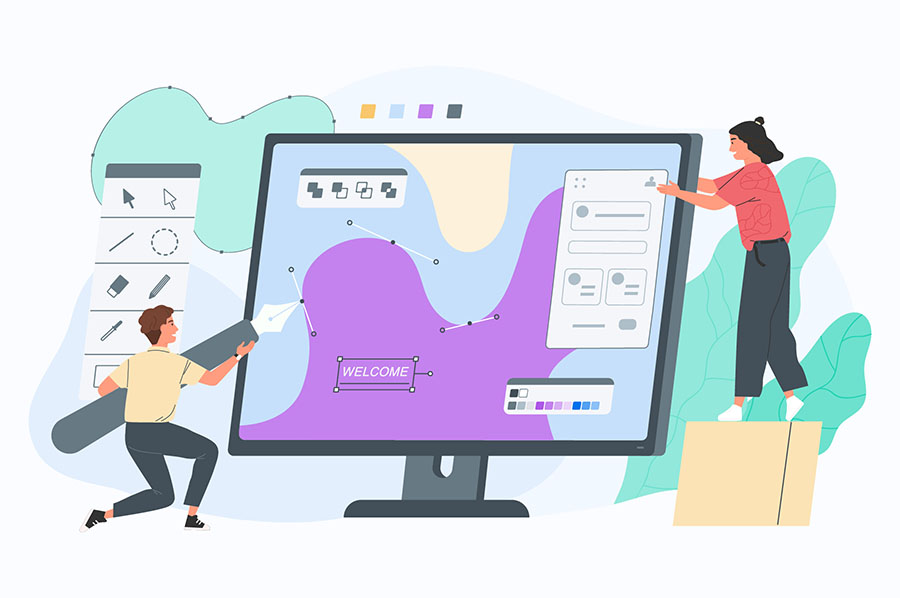The Comprehensive Overview to Crafting Aesthetically Appealing and Practical Website Design That Fulfills User Demands
In today's digital landscape, the relevance of crafting internet styles that are both aesthetically attractive and useful can not be overstated. By prioritizing user-centered style concepts, designers can produce experiences that not just attract however additionally preserve user rate of interest.
Comprehending User-Centered Layout
At the heart of effective web layout exists the principle of user-centered design, an approach that focuses on the demands, choices, and behaviors of individuals throughout the advancement procedure. This approach involves thorough research study to recognize the target market, ensuring that the end product reverberates with its designated customers. By including customer responses at every phase, developers can produce user interfaces that are not just aesthetically enticing yet instinctive and additionally practical.
User-centered style highlights empathy, needing designers to step into the users' shoes and consider their viewpoints. Strategies such as customer personas, trip mapping, and functionality testing are utilized to identify pain points and opportunities for enhancement. This repetitive procedure permits for continuous refinement, as designers adapt to progressing individual requirements and technological developments.
Incorporating user-centered design brings about raised individual satisfaction and involvement, inevitably leading to higher conversion prices and brand name loyalty. It fosters a joint atmosphere where stakeholders, including designers, designers, and individuals, collaborate to accomplish a shared vision. By putting users at the center of the design procedure, organizations can develop sites that not only satisfy business purposes but additionally offer purposeful and satisfying experiences for customers.
Key Concepts of Visual Design
Efficient aesthetic design offers as the foundation for producing easy to use and interesting sites. It incorporates several essential concepts that guide developers in crafting aesthetically pleasing and functional interfaces.
First, equilibrium plays a critical role in accomplishing aesthetic consistency. Designers must disperse elements evenly across the format to stay clear of overwhelming individuals. This can be attained via in proportion or unbalanced style methods.

Furthermore, alignment is crucial for organizing info. Consistent positioning of message and pictures cultivates a clean design, boosting overall navigating and user experience.
 Distance additionally contributes to visual clearness. Organizing associated items together help customers in understanding the connection in between various aspects, making the user interface much more user-friendly.
Distance additionally contributes to visual clearness. Organizing associated items together help customers in understanding the connection in between various aspects, making the user interface much more user-friendly.Last but not least, uniformity in design elements, such as fonts, colors, and styles, enhances brand identity and helps individuals browse the website extra easily. By incorporating these essential concepts of aesthetic style, internet developers can produce user interfaces that are not just aesthetically enticing yet user-centered and also useful.

Importance of Responsive Style
Responsive layout is an important facet of contemporary internet advancement, making certain that internet sites work effortlessly throughout a selection of tools and screen dimensions. As the net landscape progresses, the variety of devicesâEUR" ranging from mobile phones to tablets and desktop computersâEUR" requires a style strategy that accommodates all customers.
Implementing receptive design enables for a versatile format that immediately adapts based upon the customer's screen measurements. This flexibility not only enhances access but explanation likewise enhances functionality, as customers can connect and browse with the website effortlessly, no matter their device.
Additionally, online search engine like Google focus on mobile-friendly web sites in their ranking formulas. A receptive layout can considerably improve a site's SEO performance, eventually driving more web traffic and enhancing exposure.
Furthermore, responsive design reduces the need for preserving several variations of a site, enhancing updates and material administration. This efficiency translates right into price financial savings and a much more cohesive brand name experience throughout platforms.
Enhancing User Experience
User experience (UX) is a crucial part of internet design, influencing just how visitors communicate with a website and regard its worth. A well-crafted UX makes sure that users can browse without effort, discover information conveniently, and accomplish their goals successfully. The style must take into consideration the individual's journey, from the minute they come down on the site to the completion of their wanted action, whether that be purchasing, enrolling in a newsletter, or accessing information.
Crucial element that boost UX include clear navigating, responsive formats, and appealing aesthetic material. Consistency in style components such as colors, switches, and font styles promotes knowledge, making the web site feel cohesive. In addition, enhancing lots times is vital; users are less most likely to remain on a site that is slow-moving to respond.
Including availability features ensures check this site out that all individuals, consisting of those with disabilities, can communicate with the website seamlessly. User-centric style principles must assist content organization, offering appropriate details in a sensible structure. web design. By prioritizing user demands and preferences, web designers can create experiences that are not only aesthetically enticing but likewise useful, inevitably cultivating customer fulfillment and loyalty
Evaluating and Iterating Layouts
Testing and iterating styles are essential processes that follow the preliminary production of a website, making certain that the customer experience continues to be at the leading edge of any modifications. These stages entail gathering individual feedback, evaluating design efficiency, and making informed modifications to improve usability and interaction.
Efficient screening can take different forms, consisting of use testing, A/B screening, and user studies. Functionality testing enables developers to observe genuine individuals as they interact with the internet site, determining pain factors and locations for renovation. A/B testing, on the various other hand, contrasts 2 variations of a style component to establish which does much better, supplying quantifiable data to guide choices. Individual studies can offer qualitative insights, capturing customer views and preferences.
When testing is finished, the version phase starts. This includes refining the style based on the collected information, prioritizing modifications that align with user demands and organization goals. Constant iteration fosters an adaptive style approach, where the site develops in reaction to customer actions and comments. By committing to extensive testing and model, developers can develop a web site that not only satisfies visual requirements however likewise provides a smooth and enjoyable customer experience.
Conclusion
In final thought, reliable web design demands the assimilation of user-centered concepts, crucial visual design elements, and receptive structures to produce engaging interfaces. By focusing on individual needs and implementing constant testing and model, developers can fine-tune their creations to boost general contentment. The dedication to these practices not just promotes a visually enticing aesthetic but additionally makes sure performance throughout varied devices, inevitably adding to a positive customer experience and boosted engagement.
By focusing on user-centered style principles, developers can develop experiences that not only bring in however additionally maintain user passion.At the heart of why not try this out effective internet style exists the principle of user-centered layout, an ideology that prioritizes the requirements, choices, and behaviors of customers throughout the development procedure. By placing individuals at the center of the style procedure, organizations can produce websites that not just fulfill company purposes yet likewise supply rewarding and significant experiences for users.
By prioritizing user requirements and choices, internet designers can produce experiences that are not just visually enticing but likewise practical, inevitably fostering individual satisfaction and loyalty.
Individual studies can supply qualitative insights, capturing individual views and choices. (web design)